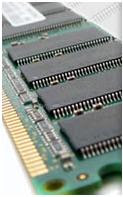The difference a fast personal computer can make in a person's life can be significant, and processing speeds depend on a number of variables. Your CPU, operating system, random-access memory, internet connection, and a whole list of other factors determine how efficiently your business or personal software operates. For instance, upgrading Dell memory helps improve your Dell system performance. By following the step-by-step instructions below, you can successfully find the right random-access memory (RAM) for all HP, Compaq, and Apple memory requirements.
 Step one: find the memory information for your model. This memory upgrade information can be found in the specifications document for your personal or business computer. Say you don't have this documentation to tell you what type of computer memory your PC needs. Going online you will find you can insure compatibility by searching for the correct RAM upgrades you need by manufacturer, model number, or part number.
Step one: find the memory information for your model. This memory upgrade information can be found in the specifications document for your personal or business computer. Say you don't have this documentation to tell you what type of computer memory your PC needs. Going online you will find you can insure compatibility by searching for the correct RAM upgrades you need by manufacturer, model number, or part number.Step two: confirm how much memory can be added to your computer. One of the most simplest ways of finding your computer's exact memory configuration and how much memory should be installed is by shutting down your computer, powering it up, and pressing the F1 or F10 key repeatedly until a BIOS Setup Screen appears (some computers may use a different key like ESC or F3). The main screen will display an Installed Memory line, which indicates the total amount of memory currently installed and the speed at which your computer is operating. The memory bank line(s) show the amount of memory for the module that is installed in that bank. You can also use the memory bank information to determine if a particular memory slot (bank) is empty.
To find the total amount of RAM that can be added, subtract the amount of RAM currently in the computer from the maximum amount of memory the computer can hold. For example, a computer has 256 MB of RAM. If the maximum amount of memory the computer can hold is 512 MB, then 256 MB is the amount of RAM that can be added. To find the amount of RAM per slot, divide the maximum amount of memory that the computer can hold with the number of memory slots on the motherboard. Usually, this is the maximum amount for each memory socket. For example, if the computer is capable of holding a maximum of 1024 MB (1 G) of memory and the motherboard has four memory slots, install 256 MB (or less) memory modules per slot. For more information on memory upgrades for your PC or Apple computer, please contact houseofmemory.com.
No comments:
Post a Comment